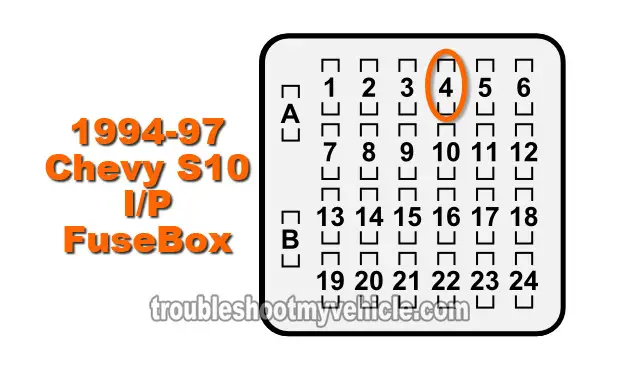TEST 2: Checking The Continuity Of The Bat (+) Cable

There's a thick (heavy gauge) wire that connects to the back of your S10's (Sonoma's, Hombre's) alternator with a nut (this stud, to which the this wire is connected to is known as the B + terminal).
This heavy gauge wire is the one that delivers the alternator's output to the battery across a fusible link (this fusible link is located on your S10's starter motor solenoid).
Just to emphasize this point a bit more, the B + wire doesn't connect directly to the battery's positive (+) terminal. It first connects to the starter motor solenoid across an inline 12 gauge fusible link. From there, it connects to the battery's positive (+) terminal.
Now, this inline 10 gauge fusible link can get blown. Once it's blown, the alternator's output can not reach the battery.
So in this test step, you're going to verify that this inline-fusible link is OK with a simple multimeter continuity test.
NOTE: The battery negative terminal must be disconnected from the battery negative post to perform this continuity test.
This is what you'll need to do:
- 1
Disconnect the battery negative (-) cable terminal from the battery negative post. The positive cable remains connected.
IMPORTANT: Don't continue to the next step without first disconnecting the negative cable from the negative battery post. - 2
After disconnecting the battery negative (-) cable, turn on your multimeter and select Ohms mode.
IMPORTANT: The engine must be cold to perform this test, or you run the risk of getting burned by the engine's hot surfaces! - 3
Your Chevy pickup's alternator has only one big wire attached to it. This wire is attached with a nut. So, place your multimeter's RED test lead on the stud to which this wire is connected to.
The arrow in the photo points to this stud. - 4
With the black multimeter test lead, probe the center of the battery positive post on your Chevy pickup's battery.
- 5
You'll get one of two results.
1.) If the inline fusible link, protecting this circuit, is blown, your multimeter will indicate a reading of OL (which means over limit). In other words, there will be NO continuity.
2.) If the inline fusible link is OK and not blown, your multimeter will register an Ohms reading of 0.5 Ohms or less. In other words, there will be continuity.
Let's take a look at what your results mean:
CASE 1: Your multimeter registered continuity. This is good, since it indicates that the inline fusible link protecting this circuit is OK and not blown.
Your next step is to check the GAUGES fuse in the instrument panel fuse box. For this test go to: TEST 3: Checking The Alternator Fuse.
CASE 2: Your multimeter DID NOT register continuity. This result tells you that the 12 gauge inline fusible link is blown and this will keep the alternator from charging the battery.
As I mentioned earlier, in this test section, this 12 gauge inline fusible link is part of the Bat + wire. It's on the end of the Bat + wire that connects to the starter motor solenoid.
Your next step is to check and replace this inline fusible link (if applicable) and retest. Replacing this 12 gauge inline fusible link (if blown) should solve your no charge condition. You'll have to investigate the reason this inline fusible link blew, since they don't get blown for no particular reason.
TEST 3: Checking The Alternator Fuse

If you've reached this point you have checked/confirmed 3 things:
One: Your S10's (Sonoma's, Hombre's) alternator is not charging the battery and the battery light is shining nice and bright on the instrument panel.
Two: The battery voltage with the engine running is below 13 Volts and decreases when you turned everything one to 10 Volts or less (TEST 1).
Three: There's continuity between the battery positive post and the battery output terminal on the alternator (TEST 2).
The next and last step is just to make sure that the alternator fuse IS NOT blown in the instrument panel fuse box.
This is what you need to do:
- 1
Reconnect the battery negative cable to the battery.
- 2
Locate the #4 GAUGES fuse in the instrument panel fuse box (see the I/P fuse box illustration in the image above).
Remove the fuse and check to see if it's blown (or not).
Let's take a look at what your test results mean:
CASE 1: The GAUGES fuse IS NOT blown. This tells you that the alternator FIELD circuit is getting power and confirms that the alternator is bad and needs to be replaced to solve the ‘no charge’ problem.
If you'd like to save some bucks on the original AC Delco or after-market alternator and belt, take a look at: Where To Buy The Alternator And Save.
CASE 2: The GAUGES fuse is blown. This tells you that the alternator's FIELD circuit is not getting power and without this battery power the alternator won't charge.
Replace the fuse and retest the alternator.

